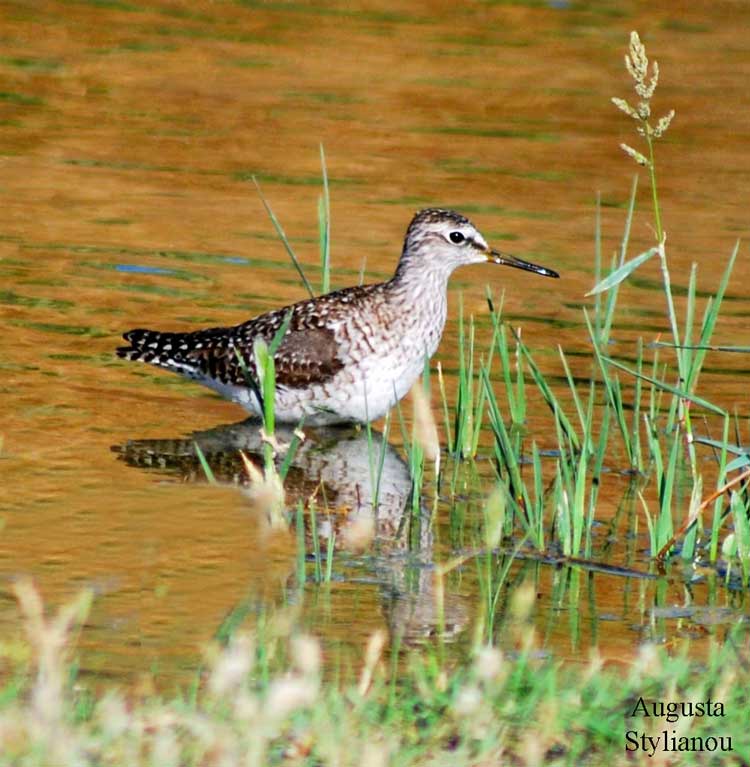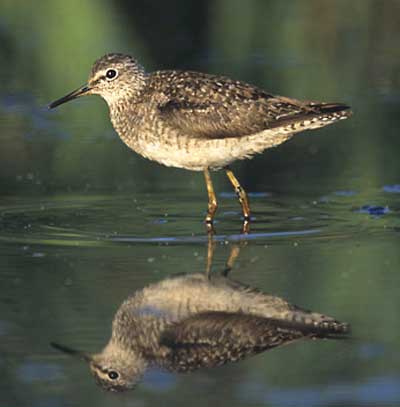
Tringa glareola , Germasogeia, Cyprus, Photo: Augusta Stylianou Artist
Superregnum: Eukaryota
Regnum: Animalia
Subregnum: Eumetazoa
Cladus: Bilateria
Cladus: Nephrozoa
Superphylum: Deuterostomia
Phylum: Chordata
Subphylum: Vertebrata
Infraphylum: Gnathostomata
Megaclassis: Osteichthyes
Superclassis: Sarcopterygii
Superclassis: Tetrapoda
Cladus: Reptiliomorpha
Cladus: Amniota
Classis: Reptilia
Cladus: Eureptilia
Cladus: Romeriida
Subclassis: Diapsida
Cladus: Sauria
Infraclassis: Archosauromorpha
Cladus: Crurotarsi
Divisio: Archosauria
Cladus: Avemetatarsalia
Cladus: Ornithodira
Subtaxon: Dinosauromorpha
Cladus: Dinosauriformes
Cladus: Dracohors
Cladus: Dinosauria
Ordo: Saurischia
Cladus: Eusaurischia
Cladus: Theropoda
Cladus: Neotheropoda
Cladus: Averostra
Cladus: Tetanurae
Cladus: Avetheropoda
Cladus: Coelurosauria
Cladus: Tyrannoraptora
Cladus: Maniraptoromorpha
Cladus: Maniraptoriformes
Cladus: Maniraptora
Cladus: Pennaraptora
Cladus: Paraves
Cladus: Eumaniraptora
Cladus: Avialae
Infraclassis: Aves
Cladus: Euavialae
Cladus: Avebrevicauda
Cladus: Pygostylia
Cladus: Ornithothoraces
Cladus: Euornithes
Cladus: Ornithuromorpha
Cladus: Ornithurae
Cladus: Carinatae
Parvclassis: Neornithes
Cohors: Neognathae
Cladus: Neoaves
Ordo: Charadriiformes
Subordo: Charadrii
Familia: Scolopacidae
Genus: Tringa
Species: Tringa glareola
Name
Tringa glareola Linnaeus, 1758
References
Linnaeus, C. 1758. Systema Naturae per regna tria naturæ, secundum classes, ordines, genera, species, cum characteribus, differentiis, synonymis, locis, Tomus I. Editio decima, reformata. Holmiæ: impensis direct. Laurentii Salvii. i–ii, 1–824 pp DOI: 10.5962/bhl.title.542: 149. Reference page.
Vernacular names
Afrikaans: Bosruiter
العربية: طيطوي الغياط
asturianu: Andarríu Pintu
অসমীয়া: বৰবালি বগুৱা
azərbaycanca: Fiyu ilbizcüllüt
башҡортса: Божор сәпсәү
беларуская: Кулік-цякун
български: Малък горски водобегач
বাংলা: বন বাটান
brezhoneg: Strelleg-geun
català: Valona
kaszëbsczi: Błotnik
čeština: Vodouš bahenní
Cymraeg: Pibydd y graean
dansk: Tinksmed
Deutsch: Bruchwasserläufer
Ελληνικά: Δασονεραλλίδα
English: Wood Sandpiper
Esperanto: Brovtringo
español: Andarríos Bastardo
eesti: Mudatilder
euskara: Kuliska pikart
فارسی: آبچلیک چوبی
suomi: Liro
føroyskt: Vaðstelkur
français: Chevalier sylvain
Gaeilge: Gobadán Coille
Gàidhlig: Luatharan coille
galego: Bilurico bastardo
Gaelg: Looyran ruy
עברית: ביצנית מנומרת
हिन्दी: Kottan
hrvatski: Prutka Migavica
magyar: Réti cankó
հայերեն: Ֆիֆի
Bahasa Indonesia: Trinil Semak
íslenska: Flóastelkur
italiano: Piro piro boschereccio
日本語: タカブシギ
ქართული: ჭაობის ჭოვილო
қазақша: Бєрте балшықшы
한국어: 알락도요
Lëtzebuergesch: Mouerwaasserleefer
lietuvių: Tikutis
latviešu: Purva tilbīte
македонски: Шумска тринга
മലയാളം: പുള്ളിക്കാടക്കൊക്ക്
монгол: Шугуйн хөгчүү - ᠰᠢᠭᠣᠢ ᠵᠢᠨ ᠬᠦᠭᠡᠴᠦ
Bahasa Melayu: Burung Kedidi Sawah
Malti: Pespus tal-Baħar
नेपाली: वन सुड्सुडिया
Nederlands: Bosruiter
norsk nynorsk: Grønstilk
norsk: Grønnstilk
polski: Łęczak
پنجابی: لکڑی آلا ریتپائیپر
português: Maçarico-bastardo
rumantsch: Trintga da pali
română: Fluierar de mlaştină
русский: Фифи
саха тыла: Чөкчөҥө
davvisámegiella: Ruonájuolcoavzzu
slovenčina: Kalužiak močiarny
slovenščina: Močvirski martinec
shqip: Qyrylyku i zallit
српски / srpski: Спрудник мигавац
Sesotho: Koe-koe-lemao
svenska: Grönbena
Kiswahili: Chamchanga-mtoni
தமிழ்: பொரி உள்ளான்
ไทย: นกชายเลนน้ำจืด
Türkçe: Orman düdükçünü
Xitsonga: N'wantshekutsheku
українська: Коловодник болотяний
Tiếng Việt: Chim Choắt bụng xám
isiXhosa: Uthuthula
Zeêuws: Bosruter
中文: 林鹬

Tringa glareola (*)
The wood sandpiper (Tringa glareola) is a small wader. This Eurasian species is the smallest of the shanks, which are mid-sized long-legged waders of the family Scolopacidae. The genus name Tringa is the New Latin name given to the green sandpiper by Aldrovandus in 1599 based on Ancient Greek trungas, a thrush-sized, white-rumped, tail-bobbing wading bird mentioned by Aristotle. The specific glareola is from Latin glarea, " gravel".[2]
Description and systematics
It resembles a longer-legged and more delicate green (T. ochropus) or solitary sandpiper (T. solitaria) with a short fine bill, brown back and longer yellowish legs. It differs from the first of those species in a smaller and less contrasting white rump patch, while the solitary sandpiper has no white rump patch at all.[3]
However, it is not very closely related to these two species. Rather, its closest relative is the common redshank (T. totanus), and these two share a sister relationship with the marsh sandpiper (T. stagnatilis). These three species are a group of smallish shanks with red or yellowish legs, a breeding plumage that is generally subdued light brown above with some darker mottling and with a pattern of somewhat diffuse small brownish spots on the breast and neck.[3][4]
Ecology
The wood sandpiper breeds in subarctic wetlands from the Scottish Highlands across Europe and then east across the Palearctic. They migrate to Africa, Southern Asia, particularly India, and Australia. Vagrant birds have been seen as far into the Pacific as the Hawaiian Islands. In Micronesia it is a regular visitor to the Mariana Islands (where flocks of up to 32 birds are reported) and Palau; it is recorded on Kwajalein in the Marshall Islands about once per decade. This species is encountered in the western Pacific region between mid-October and mid-May.[3][5][6][7] A slight westward expansion saw the establishment of a small but permanent breeding population in Scotland since the 1950s.
This bird is usually found on freshwater during migration and wintering. They forage by probing in shallow water or on wet mud, and mainly eat insects and similar small prey. T. glareola nests on the ground or uses an abandoned old tree nest of another bird, such as the fieldfare (Turdus pilaris).[3] Four pale green eggs are laid between March and May.
Adult wood sandpipers moult all their primary feathers between August and December, whilst immature birds moult varying number of outer primaries between December and April, much closer to their departure from Africa. Immatures are also much more flexible than adults in the timing and rate of their moult and refueling. Adults and immatures which accumulate fuel loads of c.50% of their lean body mass can potentially cross distances of 2397–4490 km in one non-stop flight.[8]
The wood sandpiper is one of the species to which the Agreement on the Conservation of African-Eurasian Migratory Waterbirds (AEWA) applies.
Widespread, it is considered a Species of Least Concern by the IUCN.[9]
References
BirdLife International (2016). "Tringa glareola". IUCN Red List of Threatened Species. 2016: e.T22693247A86689640. doi:10.2305/IUCN.UK.2016-3.RLTS.T22693247A86689640.en. Retrieved 12 November 2021.
Jobling, James A (2010). The Helm Dictionary of Scientific Bird Names. London: Christopher Helm. pp. 174, 390. ISBN 978-1-4081-2501-4.
Hayman, Peter; Marchant, John; Prater, Tony (1986). Shorebirds: an identification guide to the waders of the world. Boston: Houghton Mifflin. ISBN 0-395-60237-8.
Pereira, S.L.; Baker, A.J. (2005). "Multiple Gene Evidence for Parallel Evolution and Retention of Ancestral Morphological States in the Shanks (Charadriiformes: Scolopacidae)". Condor. 107 (3): 514–526. doi:10.1650/0010-5422(2005)107[0514:MGEFPE]2.0.CO;2.
Wiles, Gary J.; Worthington, David J.; Beck, Robert E. Jr.; Pratt, H. Douglas; Aguon, Celestino F.; Pyle, Robert L. (2000). "Noteworthy Bird Records for Micronesia, with a Summary of Raptor Sightings in the Mariana Islands, 1988–1999" (PDF). Micronesica. 32 (2): 257–284. Archived from the original (PDF) on 2013-04-23. Retrieved 2009-05-12.
VanderWerf, Eric A. (2006). "Observations on the birds of Kwajalein Atoll, including six new species records for the Marshall Islands" (PDF). Micronesica. 38 (2): 221–237. Archived from the original (PDF) on 2011-06-15. Retrieved 2009-05-12.
VanderWerf, Eric A.; Wiles, Gary J.; Marshall, Ann P.; Knecht, Melia (2006). "Observations of migrants and other birds in Palau, April–May 2005, including the first Micronesian record of a Richard's Pipit" (PDF). Micronesica. 39 (1): 11–29. Archived from the original (PDF) on 2011-06-15. Retrieved 2009-05-12.
Remisiewicz, M.; Tree, A. J.; Underhill, L. G.; Burman, M. S. (2017). "Age-specific variation in relationship between moult and pre-migratory fuelling in Wood Sandpipers Tringa glareola in southern Africa". Ibis. 159 (1): 91–102. doi:10.1111/ibi.12436.
"Species factsheet: Tringa glareola". www.birdlife.org. BirdLife International. 2008.
Retrieved from "http://en.wikipedia.org/"
All text is available under the terms of the GNU Free Documentation License

